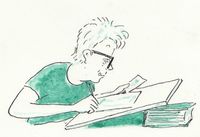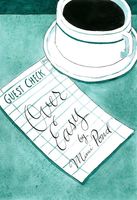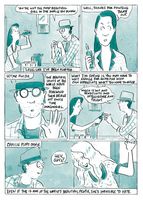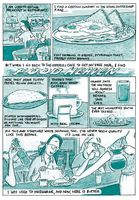Guttersnipes: Mimi Pond
By Evan Munday
TCAF is the Toronto Comic Arts Festival. It is an annual week-long celebration of comics and graphic novels and their creators, featuring readings, interviews, panels, workshops, gallery shows, art installations, and culminating in a two-day exhibition and vendor fair featuring hundreds of comics creators from around the world. The Toronto Comic Arts Festival 2014 will take place Saturday, May 10 and Sunday May 11, at Toronto Reference Library (789 Yonge Street). Admission is free. Leading up to the Festival, I'll be interviewing some of the dazzling comic writers and illustrators – particularly the Canadian ones – who have brand-new books out for TCAF.
Mimi Pond is not your typical comic-booker. Since the 1980s, she's been cartoonist, illustrator, and writer. But she's also made comics for Seventeen (!) magazine, National Lampoon, The Los Angeles Times, and many other publications, and has written and illustrated five humour books. But you might know her best as one of the writers of the very first full-length episode of The Simpsons, 'Simpsons Roasting on an Open Fire.' She's also written episodes for Designing Women and Pee Wee's Playhouse. At TCAF, she'll be presenting Over Easy (Drawn & Quarterly), a comic semi-memoir about life amongst the fast-talking, drug-experimenting crew at the Imperial Cafe in latex 1970s Oakland. Pond's stand-in, Margaret, is denied financial aid in her lat year of art school, and taking a job at the Cafe helps transform her from a naive student to a self-aware and confident artist.
Please describe, as best you can, your new comic book as an equation of movies. (e.g. Passenger 57 + Fried Green Tomatoes – unintentional cannibalism)
I hesitate to draw this analogy. Honestly, I don't think there has been any movie made that approaches the quirky world of the Imperial Cafe in Over Easy. In terms of the main characters, the only people that come close in my mind are both Orson Welles's Harry Lime from The Third Man and Bill Murray's Bob Harris from Lost in Translation. By no means do I want to suggest that Lazlo is an amoral sociopath who sells black market watered-down penicillin! I simply mean that Joseph Cotten's character, Holly Martins, comes to Vienna to reconnect with his charming old friend from school, about whom he has so many fond memories. Over the course of the story he learns Harry is not exactly the person he thought he was. At the same time, Bill Murray's character in Lost in Translation is a charismatic and fascinating, if somewhat lost man, whom, although unavailable romantically to Scarlett Johansson, has a profound impact on her.
What was your favourite comic book when you were thirteen?
What was the name and general premise of the first comic book you ever made? (That is, when you were a kid, making comics for your siblings and/or friends?)
I don't think I made whole comic books when I was a kid. I used to try to do single-panel gag comics as a result of being highly influenced by big bound collections of New Yorker cartoons. I remember drawing a lot of businessmen. I did editorial cartoons for my junior high school newspaper and also designed cartoon mastheads for columns in that paper, The Tiger Times.
Have you been to TCAF before? If so, what’s your favourite TCAF memory? If not, what are you most looking forward to?
I have never before been to TCAF. I am looking forward to the entire thing. I am very much looking forward to hanging out with other cartoonists.
Your CanLit News
Subscribe to Open Book’s newsletter to get local book events, literary content, writing tips, and more in your inbox
If you could collaborate with one other TCAF guest, who would it be (and why)?
Kate Beaton strikes me as someone with whom it would be quite fun to collaborate. Perhaps on a cartoon version of Edith Wharton's A Custom of the Country. We could have lots of fun with Undine Sprague.
What do you find the most difficult thing to write? Draw?
It is difficult to both write and draw very emotional and deeply personal scenes. I have been doing that for Part Two of Over Easy. The memory of painful events, even if they happened thirty-five years ago, has to be brought up all over again when you commit it to paper. That said, I also HAAATE to draw cars. There, I've said it. I wish I enjoyed it. A beautifully drawn car is a quite a sight. Bruce McCall does it. Lots of artists do it. It's just not my forte.
TCAF is now over ten years old. What’s the biggest change you've noticed in the world of comics in the past ten years?
Well, the graphic novel world has just exploded. It's easier now to explain to people who are not even remotely engaged in comics or graphic novels what you're doing. Yet and still, there’s more than the occasional person who fails to comprehend the concept. “'Wait. It's a book … with pictures? It's not for kids? Who draws the pictures? You do? Who does the writing? Oh. You do them both? What? It's like … a comic book?' And also there could still be more respect for cartooning as an art form.
This book is set in late 1970s Oakland. How did you manage to capture the era and geography so well, not just the events of the time, but the look of characters and mood? Were you keeping detailed sketchbooks when it all happened?
It's not that I was keeping detailed sketchbooks at the time, but the inspiration for the character Lazlo, John Veglia (aka Nestor Marzipan), and I corresponded for years after I left the restaurant. His wonderful descriptions of the gossip and drama going on there were part of what I tried to capture in the narrative. One of the other employees, Stewart Young, took many photos and kept a scrapbook of the restaurant. He loaned it to me so I could scan the photos, which were invaluable as reference. I also took hundreds of photos myself of the real restaurant, Mama's Royal Cafe, still in business 40 years later! Also I cannot emphasize too much what an incredible tool Google Street View is. Oakland has not changed so dramatically, so it was absolutely a gift.
You've said the book was fifteen years in the making and was first written as a text-only memoir. What was most daunting about reworking the material into comic form?
The most daunting aspect of course, was ALL THAT DRAWING. The manuscript was a handy road map, but drawing it all was just a huge amount of work. Luckily, I like to draw.
I've read that you now have kids in art school and your son once worked at the same restaurant featured in Over Easy. Did that in any way change or inform the book?
I had a moment or two where I felt as though I had ceded my 'ownership' of the place, but then I realized that I had a firm grip on my story and that my son would have his own.
You've had a very interesting career so far, having written for Seventeen and the first full-length Simpsons episode. Do you remember your favourite piece you wrote for Seventeen?
I really did enjoy them all. That was a fun gig!
Visit torontocomics.com to find out more about TCAF and Mimi Pond's appearance at the festival.
The views expressed in the Writer-in-Residence blogs are those held by the authors and do not necessarily reflect the views of Open Book: Toronto.
The views expressed in the Writer-in-Residence blogs are those held by the authors and do not necessarily reflect the views of Open Book.
Evan Munday is the author and illustrator of the acclaimed book series for young readers, The Dead Kid Detective Agency. Both The Dead Kid Detective Agencyand its sequel, Dial M for Morna, were nominated for the Silver Birch Fiction Award.
Evan has worked in book marketing and publicity for ten years, eight of which were as publicist at Coach House Books, and he has since worked as a freelance illustrator and ebook designer.
Find out more about Evan on his website, idontlikemundays.com or follow him on Twitter at @idontlikemunday.





